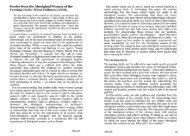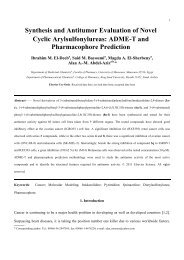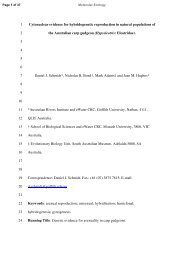Universal Primers for DNA barcoding of all Avian Species - Griffith ...
Universal Primers for DNA barcoding of all Avian Species - Griffith ...
Universal Primers for DNA barcoding of all Avian Species - Griffith ...
Create successful ePaper yourself
Turn your PDF publications into a flip-book with our unique Google optimized e-Paper software.
oth historical and modern. The primers generated by us are an example <strong>of</strong> such sets (Figure<br />
1). These primers, designed to amplify the barcode region <strong>of</strong> historical and modern samples<br />
from New Zealand and Antarctic bird species proved gener<strong>all</strong>y successful with only a few<br />
exceptional taxa, such as the Apterygi<strong>for</strong>mes requiring specialised primers. Since these<br />
primers were designed using an alignment <strong>of</strong> sequences from a range <strong>of</strong> both Northern and<br />
Southern Hemisphere species, it is likely that they will be effective <strong>for</strong> avian orders from<br />
many geographic locations. It is important to note that there are a number other primers<br />
published that are not tested in this study which could prove to be highly useful (Lohman et<br />
al. 2009; Tavares & Baker 2008). However, our primers have a very broad applicability,<br />
having been tested on large number <strong>of</strong> species from 17 avian orders. All primers generated<br />
high quality sequences <strong>for</strong> the region <strong>of</strong> interest. <strong>Primers</strong> designed <strong>for</strong> modern samples had<br />
binding sites at least 80bp from the start and end <strong>of</strong> the barcode region to <strong>all</strong>ow <strong>for</strong> good<br />
overlapping bi-directional sequence and to make <strong>all</strong>owance <strong>for</strong> the loss <strong>of</strong> sequence data<br />
which occurs at the beginning <strong>of</strong> each sequence read.<br />
To maximise chances <strong>of</strong> obtaining amplifiable <strong>DNA</strong> from historical specimens we suggest<br />
sampling from the toe pad area where the risk <strong>of</strong> damage from preservatives is minimal.<br />
Specimen age should also be carefully considered and where possible, younger specimens<br />
should be selected <strong>for</strong> <strong>DNA</strong> analysis.<br />
The 648bp barcode region <strong>for</strong> historical avian specimens can now be amplified using tagged<br />
internal primers as either three or five fragments, depending on the <strong>DNA</strong> quality <strong>of</strong> individual<br />
samples. We suggest using the set <strong>of</strong> primers containing three primer pairs since the<br />
likelihood <strong>of</strong> achieving success with the set <strong>of</strong> three primers pairs is the same as that from the<br />
set <strong>of</strong> five primer pairs. As our results demonstrate, if one set <strong>of</strong> internal primers does not<br />
prove successful the other set is unlikely to work either. In the event that not <strong>all</strong> overlapping<br />
fragments are amplified there is the added possibility <strong>of</strong> using one or more <strong>of</strong> these sm<strong>all</strong>er<br />
fragments as a mini-barcode once this approach has be confirmed to work <strong>for</strong> avian taxa.<br />
The addition <strong>of</strong> 5’-tags to each <strong>of</strong> the internal primers provides a number <strong>of</strong> advantages. Not<br />
only does it result in an increase in the read length <strong>of</strong> each sequence, thus <strong>all</strong>owing <strong>for</strong> better<br />
overlap <strong>of</strong> individual contigs, but it has been shown to greatly improve sequence quality<br />
(Binladen et al. 2007). This is crucial <strong>for</strong> historical samples where <strong>DNA</strong> damage is frequent.<br />
The 5’-tags also <strong>all</strong>ow <strong>for</strong> large-scale sequencing as well as being more cost effective, as only<br />
9





